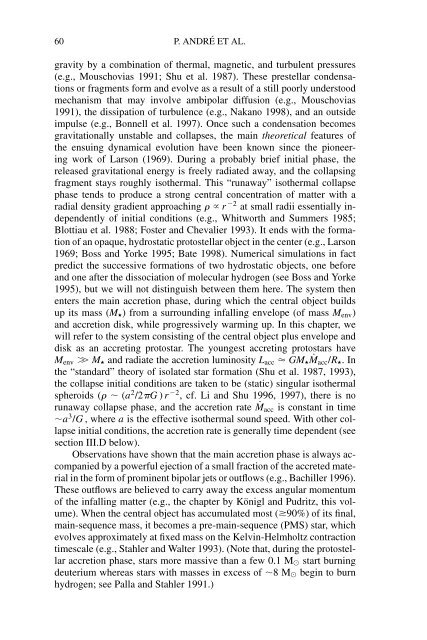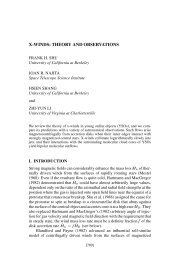from prestellar cores to protostars - The University of Arizona Press
from prestellar cores to protostars - The University of Arizona Press
from prestellar cores to protostars - The University of Arizona Press
Create successful ePaper yourself
Turn your PDF publications into a flip-book with our unique Google optimized e-Paper software.
´<br />
60 P. ANDRE ET AL.<br />
gravity by a combination<br />
<strong>of</strong> thermal, magnetic, and turbulent pressures<br />
(e.g., Mouschovias 1991; Shu et al. 1987). <strong>The</strong>se <strong>prestellar</strong> condensa-<br />
tions or fragments form and evolve as a result <strong>of</strong> a still poorly unders<strong>to</strong>od<br />
mechanism that may involve ambipolar diffusion (e.g., Mouschovias<br />
1991), the dissipation <strong>of</strong> turbulence (e.g., Nakano 1998), and an outside<br />
impulse (e.g., Bonnell et al. 1997). Once such a condensation becomes<br />
gravitationally unstable and collapses, the main theoretical features <strong>of</strong><br />
the ensuing dynamical evolution have been known since the pioneer-<br />
ing work<br />
<strong>of</strong> Larson (1969). During a probably brief initial phase, the<br />
released gravitational energy is freely radiated away, and the collapsing<br />
fragment stays roughly isothermal. This “runaway” isothermal collapse<br />
phase tends <strong>to</strong> produce a strong central concentration <strong>of</strong> matter with a<br />
<br />
radial density gradient approaching<br />
r<br />
2<br />
at small radii essentially independently<br />
<strong>of</strong> initial conditions (e.g., Whitworth and Summers 1985;<br />
Blottiau et al. 1988; Foster and Chevalier 1993). It ends with the forma-<br />
tion <strong>of</strong> an opaque, hydrostatic pro<strong>to</strong>stellar object in the center (e.g., Larson<br />
1969; Boss and Yorke 1995; Bate 1998). Numerical simulations in fact<br />
predict the successive formations <strong>of</strong> two hydrostatic objects, one before<br />
and one after the dissociation <strong>of</strong> molecular hydrogen (see Boss and Yorke<br />
1995), but we will not distinguish between them here. <strong>The</strong> system then<br />
enters the main accretion phase, during which the central object builds<br />
up its mass ( M) <strong>from</strong> a surrounding infalling envelope ( <strong>of</strong> mass Menv)<br />
and accretion disk, while progressively warming up. In this chapter, we<br />
will refer <strong>to</strong> the system consisting <strong>of</strong> the central object plus envelope and<br />
disk as an accreting proo t star. <strong>The</strong> youngest accreting proo<br />
t . stars have<br />
Menv M and radiate the accretion luminosity Lacc GMMacc/ R. In<br />
the “standard” theory <strong>of</strong> isolated star formation (Shu et al. 1987, 1993),<br />
the collapse initial conditions are taken <strong>to</strong> be (static) singular isothermal<br />
a2 <br />
spheroids ( ( /2 G) r<br />
2, cf. Li and Shu 1996, . 1997), there is no<br />
runaway collapse phase, and the accretion rate Macc<br />
is constant in time<br />
a3/ G, where a is the effective isothermal sound speed. With other col-<br />
lapse initial conditions, the accretion rate is generally time dependent (see<br />
section III.D below).<br />
Observations have shown that the main accretion phase is always accompanied<br />
by a powerful ejection <strong>of</strong> a small fraction <strong>of</strong> the accreted material<br />
in the form <strong>of</strong> prominent bipolar jets or outflows (e.g., Bachiller 1996).<br />
<strong>The</strong>se outflows are believed <strong>to</strong> carry away the excess angular momentum<br />
<strong>of</strong> the infalling matter (e.g., the chapter by Ko¨<br />
nigl and Pudritz, this vol-<br />
ume). When the central object has accumulated most ( 90%) <strong>of</strong> its final,<br />
main-sequence mass, it becomes a pre-main-sequence (PMS) star, which<br />
evolves approximately at fixed mass on the Kelvin-Helmholtz contraction<br />
timescale (e.g., Stahler and Walter 1993). (Note that, during the pro<strong>to</strong>stel-<br />
lar accretion phase, stars more massive than a few 0.1 M<br />
start burning<br />
deuterium whereas stars with masses in excess <strong>of</strong> 8 M<br />
begin <strong>to</strong><br />
burn<br />
hydrogen; see Palla and Stahler 1991.)






